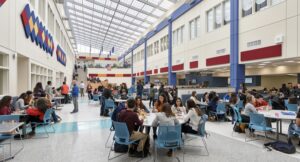October 18, 2023
Reading Time: 4 minutes
Frank J. Gargiulo Campus School, Hudson County Schools of Technology, Secaucus, NJ. Design/ Bridging Architect: RSC Architects. Design/ Build Architect of Record: DRM Architects
Following up on last month’s release, the New Jersey Chapter of the American Insitute of Architects Safe School Design Task Force continues sharing its research and findings on best practices to improve the health, safety, and welfare of NJ PK-12 schools. This time, the investigations tackle three topics related to providing healthy environments by choosing better and more “Hygienic Materials,” by selecting better “Indoor Air Quality and Ventilation,” and by promoting daylight, energy reduction, and improving learning environments by choosing healthy “Daylight and Lighting.”
Healthier Schools
Healthier Schools should be an easy sell and a mission people can get behind. Still, with endless options to explore in selecting materials, systems, and components that go into a building, doing so can be daunting, especially while maintaining durability and budget. The Task Force aims to provide resources while promoting healthy strategies for PK-12 schools to succeed in this mission. It is an important one, as the building occupants, students, staff, and teachers spend much of their day inside the school, sometimes even in the same room throughout the day, and these health-focused strategies can help reduce ailments due to poor indoor air quality, decrease distractions, and promote well-being. With that said, we are debuting Heathier Schools with three topics and continue the series with additional topics in the future.
Hygienic Materials
On the topic of “Hygienic Materials,” we explore that many materials often found in schools can contain harmful properties leading to a wide range of health impacts. We also stress the importance of avoiding certain compounds that cause these health impacts while offering some solutions and resources to explore further. In short, the advice on this topic is to keep occupants health as high of a goal as cost and durability usually are when selecting school materials. Architects, Consultants, and Product Experts can help sort through materials that limit or don’t contain properties harmful to the indoor environment.
Indoor Air Quality and Ventilation
On the topic of “Indoor Air Quality and Ventilation,” we explore the dangers that can affect students in the indoor building environment when suitable HVAC, filtration, and air cleaner systems are
not selected, and we cover how to choose better systems for the classroom. When appropriate systems are not chosen, these effects on students can include headaches, dizziness, asthma, absenteeism, poor student attendance, and low test scores. In addition, this topic is even more critical during the Pandemic and post-pandemic world as we are now more accurately aware of the dangers of prolonged exposure to airborne pathogens. Following the recommendations in the guidelines released by the ASHRAE COVID Epidemic Task Force, we can select from a wide range of options to reduce airborne pathogens and all the other effects listed above. In short, we can reduce the impacts of many issues by targeting six equivalent air changes per hour through a combination of outdoor ventilation, HVAC filtration, and the possibility of introducing air cleaners or ultraviolet germicide systems.
Daylight and Lighting
On the topic of “Daylight and Lighting,” we explore the importance of light properties, outdoor views, and energy reduction to achieve classrooms that promote student attention, the ability to read with better clarity, and the benefits for students, which include significantly faster recovery from stress and mental fatigue, and performing considerably higher on tests of attentional functioning. These recommendations and practices covered include using the latest technology in LED, stressing the importance of planning out light fixture spacing and placement, using daylighting whenever possible, and controlling brightness, contrast, and temperature to affect the space that is being illuminated.
We recommend reading each of our papers in more detail to provide healthier schools and improve learning environments. The Task Force looks forward to continuing to share our findings so that together, with community input, we can create better schools for our children and grandchildren.
Our AIA NJ Safe School Design Task Force has prepared “whitepapers” on various topics, including how design impacts school culture and climate, combats bullying, supports mental health, helps secure funding for safety upgrades, and provides health environments.
 ABOUT THE AUTHOR:
ABOUT THE AUTHOR:
Chris Brand, AIA, is an AIA NJ Safe School Design Task Force member. He is a Project Manager at RSC Architects and has over 10 years of experience as an Architect and Educational Facility Planner with expertise in designing PK-12 schools, vocational schools, and colleges. He also serves as an executive board member of the Architects League of Northern New Jersey and a Member of the K-12 AIA-NJ committee.
PHOTOS: The included slideshow features images from the following projects…
By Stacey Ruhle Kliesch, AIA, AIA NJ Advocacy Consultant | Posted in AIA-NJ News, Architecture in NJ | Tagged: #AIANJ, #aianjarchitects, #aianjsafeschoolstaskforce, #ChrisBrandAIA, #daylight, #Health, #healthyschools, #healthystudents, #hygienicmaterials, #indoorairquality, #MentalHealth, #NJArchitects, #safeschools, #safestudents, #Safety, #ventilation, #Welfare, #wellness, HSW | Comments (0)
Architects are creative professionals, educated, trained, and experienced in the art and science of building design, and licensed to practice architecture. Their designs respond to client needs, wants and vision, protect public safety, provide economic value, are innovative, inspire and contribute positively to the community and the environment.

414 Riverview Plaza, Trenton, NJ 08611
(609) 393-5690
info@aia-nj.org